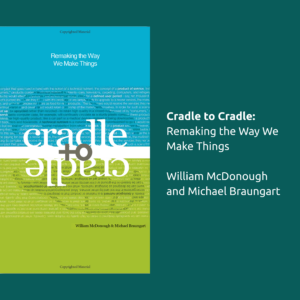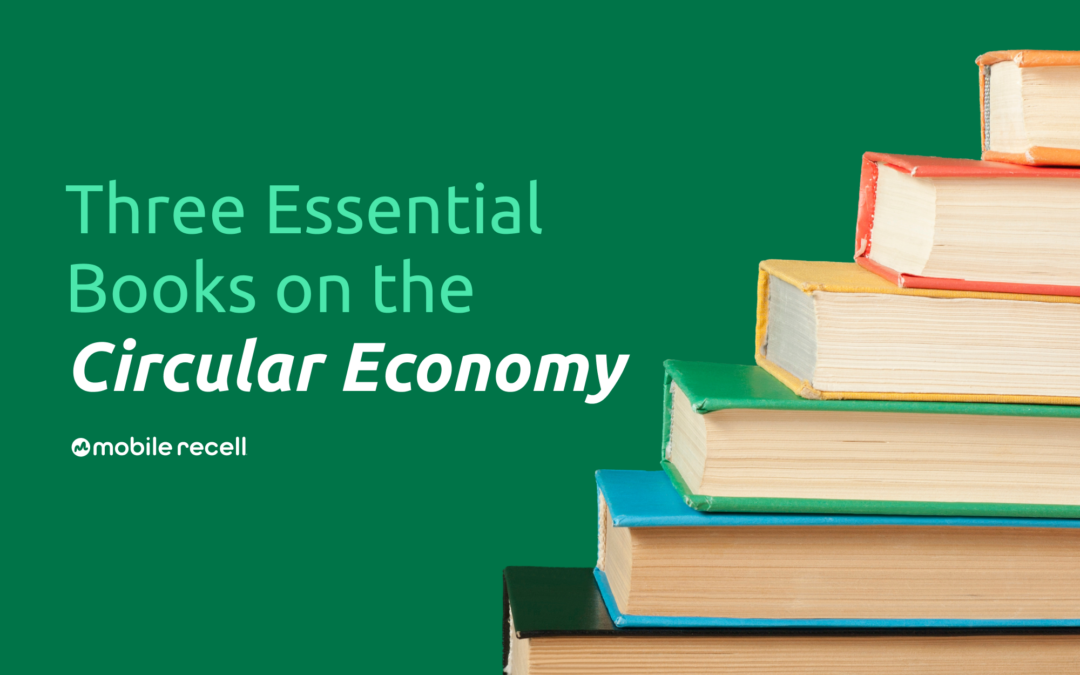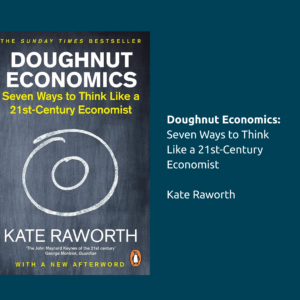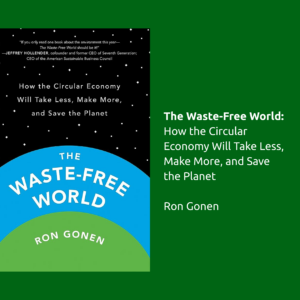The circular economy has been a popular topic of discussion lately in sustainability spaces. Although the circular economy can seem complex, it is extremely beneficial to those who participate in it.
Part of Mobile reCell’s mission is to maximize the impact we make, which we have largely contributed to through our education of and advocacy for the circular economy. So, you’ve probably heard us mention the circular economy more recently, and perhaps you’d like to know more about it.
With National Book Lovers Day on August 9, we teamed up with our Vice President of Sustainability, Allyson Mitchell, and put together a few book recommendations to help you expand your knowledge of the circular economy and maybe even blow your mind with inspiration!
These three books will meet you wherever you are on your understanding of the circular economy, and will appeal to those interested in any or all of the three layers of sustainability: environmental, social, and economic. We recommend these books as they strike a good balance between explaining the scientific and technical details of the circular economy and providing readers with practical and real-world examples of circularity in action.
Three Books About the Circular Economy You Should Read and Why
 Book #1: Cradle to Cradle: Remaking the Way We Make Things by William McDonough and Michael Braungart
Book #1: Cradle to Cradle: Remaking the Way We Make Things by William McDonough and Michael Braungart
Published in 2002, this was the first mainstream book about the circular economy and introduced several key principles. Co-authored by Bill McDonough, an architect, speaker, and globally recognized leader in sustainable development and design, and German chemist and visionary environmental thinker Michael Braungart, this book challenges the linear, wasteful model of traditional manufacturing in intriguing ways.
Cradle to Cradle is a fundamental read for understanding the principles of the circular economy, how nature provides the inspiration needed to reimagine modern society’s relationship with materials, and why transitioning to a circular economy is imperative. This book is the one our sustainability expert, Allyson Mitchell, gives out most frequently to friends and colleagues interested in learning about the circular economy.
This book has aged very well, which is notable since its focused on a rapidly evolving and expanding field. The book itself will even physically age very well because it is made out of synthetic plastic resin, which is durable and recyclable, allowing readers to tangibly experience circularity! So buy the hard copy of this one; you will probably want to pass it along to someone else to read when you’ve finished it, anyway!
 Book #2: Doughnut Economics: Seven Ways to Think Like a 21st-Century Economist by Kate Raworth
Book #2: Doughnut Economics: Seven Ways to Think Like a 21st-Century Economist by Kate Raworth
If you are particularly interested in economics or the broader context for how circularity is transformative for systems of wealth, politics, commerce, environmental sustainability, and social stability, Doughnut Economics is the book for you.
Published in 2017 and deemed a best-selling book, author Kate Raworth posits the idea that it’s (beyond) time to revisit the way we think about economics in order to save our planet and our livelihoods. In the book, she introduces her doughnut diagram, which is a simple yet profound way of illustrating the “too much” and “too little” planetary boundaries and social needs for political stability and human prosperity. She explains how traditional economic models depend on constant and sustained growth rather than on prosperity for all, and uses diverse examples to illustrate how finance, policy, and business can shift to become regenerative and accessible to all.
Our sustainability expert Allyson Mitchell recommends the audiobook version of Doughnut Economics because the author narrates it with compelling and inspiring enthusiasm. Mitchell also recommends listeners refer to the illustration supplement often while listening, as the illustrations are key to grasping the concepts.
Based in the United Kingdom, Kate Raworth is a self-described renegade economist focused on making economics fit for 21st century realities. A great primer before reading Doughnut Economics is her standing-ovation TED Talk; there’s no way you will watch it and not immediately reach for her book!
 Book #3: The Waste-Free World: How the Circular Economy Will Take Less, Make More, and Save the Planet by Ron Gonen
Book #3: The Waste-Free World: How the Circular Economy Will Take Less, Make More, and Save the Planet by Ron Gonen
The Waste-Free World was published in 2021 and written by entrepreneur and sustainability expert Ron Gonan, CEO of Closed Loop Partners, a New York based investment firm focused on the circular economy.
The Waste-Free World is a great book to read after Cradle to Cradle and Doughnut Economics because it essentially explains how the circular economy works, illuminating the path forward from the business perspective. Additionally, Gonan makes the business case for the circular economy, explaining why more companies should adopt the framework and drawing on dozens of examples in all sectors and across industries.
This book is particularly inspiring for entrepreneurs in tech because it demonstrates the role technology plays in facilitating the shift from linear to circular in business models, supply chains, and consumer behavior. It also elevates the readers’ awareness of circularity all around them and encourages them to explore their daily lives with a new curiosity by asking themselves: “How could this linear process be redesigned into a circular, regenerative business model?”
Why Learning About the Circular Economy is Important
Learning about the circular economy will enable you to see the world through a new lens, and you may find yourself questioning the status quo and challenging processes and behaviors you once took for granted.
If you read any (or all!) of the books recommended above, our VP of Sustainability, Allyson Mitchell, would love to hear from you. What did you think? Did you have any aha moments, moments of intrigue, or inspiration? Are you seeing examples of or opportunities for circular systems design all around you? What is your sense of the imperativeness of shifting society towards a circular economy, or overcoming the obstacles to achieving it?
There are endless possibilities and opportunities for circular redesign in everything that exists in a linear model today. As more organizations shift their strategies to include sustainable practices, the growth potential in circular solutions and products is massive.
A recent report by Circular Citizen, an ally in the circular economy industry that serves as a catalyst for change, breaks down this idea by discussing consumer mindset shifts regarding personal assets and the market opportunities for capitalizing on it.
One of the best ways to serve as a catalyst for change—or bring change—is by continually educating yourself on the latest news, theories, and trends. We hope these resources will pave the way for your journey into the circular economy.
If you have questions about how to start prioritizing reuse, reducing waste, and recovering more value with the mobile devices in your IT asset recovery program, chat with us. We’d love to help you learn how integrating circularity into your IT strategy can benefit your community, your profits, and the planet.
Follow us on social media!
See Mobile reCell’s Recovery Platform in action.


 Book #2:
Book #2:  Book #3:
Book #3: